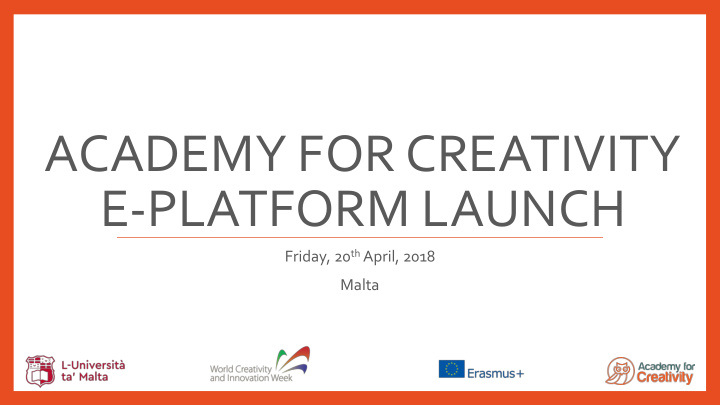



ACADEMY FOR CREATIVITY E-PLATFORM LAUNCH Friday, 20 th April, 2018 Malta
CREATIVITY IN EDUCATION Keynote Speaker, Shirley Pulis Xerxen
Some findings Source: Adobe Creativity in Education Why It Matters Study , study based on interviews with 1000 US college educated and full-time salaried employees +25
Some findings Source: Adobe Creativity in Education Why It Matters Study , study based on interviews with 1000 US college educated and full-time salaried employees +25
DEFINING CREATIVITY
2 key components
George Land’s Creativity Test • In 1968, George Land conducted a research study to test the creativity of 1,600 children ranging in ages from three-to-five years old who were enrolled in a Head Start program. This was the same creativity test he devised for NASA to help select innovative engineers and scientists. The assessment worked so well he decided to try it on children. He re-tested the same children at 10 years of age, and again at 15 years of age. The results were astounding.
George Land’s Creativity Test • Test results amongst 5 year olds: Test results amongst 10 year olds: Test results amongst 15 year olds: Same test given to 280,000 adults:
George Land’s Creativity Test • Test results amongst 5 year olds: 98% Test results amongst 10 year olds: Test results amongst 15 year olds: Same test given to 280,000 adults:
George Land’s Creativity Test • Test results amongst 5 year olds: 98% Test results amongst 10 year olds: 30% Test results amongst 15 year olds: Same test given to 280,000 adults:
George Land’s Creativity Test • Test results amongst 5 year olds: 98% Test results amongst 10 year olds: 30% Test results amongst 15 year olds: 12% Same test given to 280,000 adults:
George Land’s Creativity Test • Test results amongst 5 year olds: 98% Test results amongst 10 year olds: 30% Test results amongst 15 year olds: 12% Same test given to 280,000 adults: 2%
George Land’s Creativity Test • “What we have concluded,” wrote Land, “is that non-creative behaviour is learned.” (Source: George Land and Beth Jarman, Breaking Point and Beyond. San Francisco: HarperBusiness, 1993)
Conclusion • Educators should not bother with nurturing creativity in learners BUT • Engage learners in the UNLEARNING of NON- CREATIVITY
Creative characteristics • strong motivation, • strong self-confidence, • endurance, • openness to impressions from within and without, • intellectual curiosity, • an attraction to complexity and • deep commitment, obscurity, • independence in thought and action, • high sensitivity • a strong desire for self-realisation, • high capacity for emotional involvement in their investigations. • a strong sense of self,
… Creative characteristics • Brolin (1992) as quoted in Craft (2001) • Brolin, C. (1992). ‘ Kreativitet och kritiskt tandande. Redsckap for framtidsberedskap ’. [Creativity and critical thinking. Tools for preparedness for the future] in Krut, 53, 64-71. • • Craft, A. (2001). An Analysis of Research and Literature on Creativity in Education . Report prepared for the Qualifications and Curriculum Authority.
Amabile’s Componential Model of Creativity • 3 components • Knowledge-related skills • Creativity-related skills • Intrinsic Motivation
Kaufman and Beghetto (2007, 2009) • 4 C Model of Creativity Eminent Creativity Everyday Creativity Pro-C Creativity
Our project team
Our dream Give everyone knowledge about - and access to - creativity training
We asked ourselves Can we make embodied creativity training digital to overcome some of these issues?
Our project vision Make creativity training accessible for all educational institutions across the world through an E-Module that can be integrated into existing teaching
CReativity E-MOdules in Education • 3 year Erasmus+ strategic partnership project • Budget of: € 397.185
2.5 years later
Academy for Creativity • 10 different games with 3 levels in each, training different creative qualities • Teachers can setup “courses” ranging from 15 minutes to 50 hours of training – enough levels to train this long • Extra: reflective exercises in “The Archive” for Creative Self - Efficacy • Based on research (offline exercises) to secure validity and under continuous research
Preliminary learnings – good idea to... • Start out by playing the games in-class • Introduce creativity theory before initiating a training course • Make in-class discussions about creativity theory and relate it to the specific domain/context - makes it easier to understand what is happening • Make the creativity training through Academy for Creativity mandatory – not voluntary • Stick to the allocated training time (research suggests 10 hours of training – but can be less) – and not in one or two days only
Project outcomes (so far) • Free online creativity training (also after the project ends) • More than 20.000 people (unique visitors) have gained knowledge about creativity training through Academy for Creativity • New research under development: • Digital embodied creativity training • Attention and Emotional Response on Creativity Training: Digital versus Paper and Pencil (neuroscience led by our partners in Madrid) • Digital Creativity Training: Improvements on Creative Self-Efficacy, Creative production, Transfer effects, and Motivations for Creativity Training • ...and a huge database for further research
Further visions • Potentially spin-off projects where we move from domain general to domain specific creativity training (but we needed to develop the domain general first) • Disseminate Academy for Creativity to other users - companies and/or private individuals
Recommend
More recommend